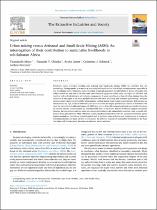| dc.contributor.author | Moyo, Thandazile | |
| dc.contributor.author | Chitaka, Takunda Y. | |
| dc.contributor.author | Lotter, Aysha | |
| dc.date.accessioned | 2023-03-22T08:50:52Z | |
| dc.date.available | 2023-03-22T08:50:52Z | |
| dc.date.issued | 2022 | |
| dc.identifier.citation | Moyo, T. et al. (2022). Urban mining versus Artisanal and Small-Scale Mining (ASM): An interrogation of their contribution to sustainable livelihoods in sub-Saharan Africa. The Extractive Industries and Society, 12, 101173. https://doi.org/10.1016/j.exis.2022.101173 | en_US |
| dc.identifier.issn | 2214-790X | |
| dc.identifier.uri | https://doi.org/10.1016/j.exis.2022.101173 | |
| dc.identifier.uri | http://hdl.handle.net/10566/8625 | |
| dc.description.abstract | Electronic waste (e-waste) recycling and artisanal and small-scale mining (ASM) are activities that are
increasingly finding uptake as a means of providing livelihoods in the face of high unemployment, especially in
the developing world. Informal e-waste recycling is typically practiced by individuals or groups of people who
collect end-of-use and end-of-life electronic and electrical equipment which they can repair or refurbish and
resell as well as break down to sell valuable components. E-waste recycling is a form of urban mining; thus, the
intention of the paper is to draw parallels between this form of mining and artisanal gold mining. Artisanal
miners extract virgin minerals while ‘urban miners’ reclaim metals from various waste streams. Both sectors are
characterized by high levels of informality and their activities are largely practiced as a means of livelihood. We
used the sustainable livelihoods framework (SLF) as a tool to draw this comparison based on available literature
on the two sectors, complemented by anecdotal field data. It was found that the livelihood capitals are similar
between the two sectors and that there are strong similarities in the vulnerability contexts, with a notable dif-
ference being that informal ASM, which has a more significant interaction with the natural environment, places
higher demands on natural and physical capital such as land and water pollution and limited access to transport.
Recommendations are made on how to strengthen the different capitals of sustainable livelihoods in the hope
that these will inform policy decisions on informal sector activities. | en_US |
| dc.language.iso | en | en_US |
| dc.publisher | Elsevier | en_US |
| dc.subject | Recycling | en_US |
| dc.subject | Gold mining | en_US |
| dc.subject | Pollution | en_US |
| dc.subject | Unemployment | en_US |
| dc.subject | sub-Saharan Africa | en_US |
| dc.title | Urban mining versus Artisanal and Small-Scale Mining (ASM): An interrogation of their contribution to sustainable livelihoods in sub-Saharan Africa | en_US |
| dc.type | Article | en_US |

